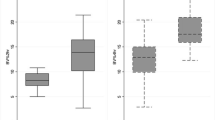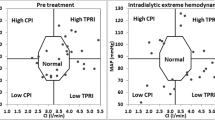Abstract
Background
Pediatric hemodialysis (HD) patients have a high incidence of cardiovascular morbidity and mortality. The study aim was to investigate whether impedance cardiography (electrical velocimetry, EV) is suitable as a hemodynamic trend monitoring tool in pediatric patients during HD.
Methods
Measurements by EV were obtained before, during, and after HD in a prospective single-center pediatric observational study. In total, 54 dialysis cycles in four different pediatric patients with end-stage kidney disease on chronic HD were included. EV parameters analyzed were heart rate (HR), stroke volume (SV), stroke volume index (SI), cardiac output (CO), cardiac index (CI), thoracic fluid content (TFC), index of contractility (ICON), stroke volume variation (SVV), variation of ICON (VIC), R-R interval (TRR), pre-ejection period (PEP), left ventricular ejection time (LVET), and systolic time ration (STR). Systemic vascular resistance index (SVRI) was calculated.
Results
EV did measure significant changes in cardiovascular parameters associated with HD. The following parameters increased after HD: HR (9%), SVV (19%), VIC (33%), PEP (8%), and STR (18%). A decrease after HD was measured in SV (18%), SI (18%), CO (10%), CI (10%), TFC (10%), ICON (7%), TRR (7%), LVET (8%), and LVET (8%). SVRI was not affected by HD. The changes were correlated to ultrafiltration. HD cycles without fluid withdrawal also altered cardiovascular parameters.
Conclusions
Pediatric HD with and without fluid withdrawal changes hemodynamic EV monitoring parameters. Possibly EV may be useful to optimize HD management in pediatric patients.



Similar content being viewed by others
References
Oh J, Wunsch R, Turzer M, Bahner M, Raggi P, Querfeld U, Mehls O, Schaefer F (2002) Advanced coronary and carotid arteriopathy in young adults with childhood-onset chronic renal failure. Circulation 106:100–105
Querfeld U, Schaefer F (2018) Cardiovascular risk factors in children on dialysis: an update. Pediatr Nephrol. https://doi.org/10.1007/s00467-018-4125-x
Kubicek WG, Karnegis JN, Patterson RP, Witsoe DA, Mattson RH (1966) Development and evaluation of an impedance cardiac output system. Aerosp Med 37:1208–1212
Osypka MJ, Bernstein DP (1999) Electrophysiologic principles and theory of stroke volume determination by thoracic electrical bioimpedance. Review. AACN Clin Issues 10:385–399
Onofriescu M, Mardare NG, Segall L, Voroneanu L, Cuşai C, Hogaş S, Ardeleanu S, Nistor I, Prisadă OV, Sascău R, Covic A (2012) Randomized trial of bioelectrical impedance analysis versus clinical criteria for guiding ultrafiltration in hemodialysis patients: effects on blood pressure, hydration status, and arterial stiffness. Int Urol Nephrol 44:583–591. https://doi.org/10.1007/s11255-011-0022-y
Moissl U, Arias-Guillén M, Wabel P, Fontseré N, Carrera M, Campistol JM, Maduell F (2013) Bioimpedance-guided fluid management in hemodialysis patients. Clin J Am Soc Nephrol 8:1575–1582. https://doi.org/10.2215/CJN.12411212
Hur E, Usta M, Toz H, Asci G, Wabel P, Kahvecioglu S, Kayikcioglu M, Demirci MS, Ozkahya M, Duman S, Ok E (2013) Effect of fluid management guided by bioimpedance spectroscopy on cardiovascular parameters in hemodialysis patients: a randomized controlled trial. Am J Kidney Dis 61:957–965. https://doi.org/10.1053/j.ajkd.2012.12.017
Raaijmakers E, Faes TJ, Scholten RJ, Goovaerts HG, Heethaar RM (1999) A meta-analysis of three decades of validating thoracic impedance cardiography. Crit Care Med 27:1203–1213
Tomaske M, Knirsch W, Kretschmar O, Balmer C, Woitzek K, Schmitz A, Bauersfeld U, Weiss M, Working Group on Noninvasive Haemodynamic Monitoring in Paediatrics (2009) Evaluation of the Aesculon cardiac output monitor by subxiphoidal Doppler flow measurement in children with congenital heart defects. Eur J Anaesthesiol 26:412–415. https://doi.org/10.1097/EJA.0b013e3283240438
Schubert S, Schmitz T, Weiss M, Nagdyman N, Huebler M, Alexi-Meskishvili V, Berger F, Stiller B (2008) Continuous, non-invasive techniques to determine cardiac output in children after cardiac surgery: evaluation of transesophageal Doppler and electric velocimetry. J Clin Monit Comput 22:299–307. https://doi.org/10.1007/s10877-008-9133-0
Raue W, Swierzy M, Koplin G, Schwenk W (2009) Comparison of electrical velocimetry and transthoracic thermodilution technique for cardiac output assessment in critically ill patients. Eur J Anaesthesiol 26:1067–1071. https://doi.org/10.1097/EJA.0b013e32832bfd94
Wang DJ, Lee IS, Chou AH, Chen CY, Ting PC, Teng YH, Lin JR, Tsai HI (2018) Non-invasive cardiac output measurement with electrical velocimetry in patients undergoing liver transplantation: comparison of an invasive method with pulmonary thermodilution. BMC Anesthesiol 18:138. https://doi.org/10.1186/s12871-018-0600-y
Petter H, Erik A, Björn E, Göran R (2011) Measurement of cardiac output with non-invasive Aesculon impedance versus thermodilution. Clin Physiol Funct Imaging 31:39–47. https://doi.org/10.1111/j.1475-097X.2010.00977.x
Trinkmann F, Berger M, Doesch C, Papavassiliu T, Schoenberg SO, Borggrefe M, Kaden JJ, Saur J (2016) Comparison of electrical velocimetry and cardiac magnetic resonance imaging for the non-invasive determination of cardiac output. J Clin Monit Comput 30:399–408. https://doi.org/10.1007/s10877-015-9731-6
Schmidt C, Theilmeier G, Van Aken H, Korsmeier P, Wirtz SP, Berendes E, Hoffmeier A, Meissner A (2005) Comparison of electrical velocimetry and transoesophageal Doppler echocardiography for measuring stroke volume and cardiac output. Br J Anaesth 95:603–610
Norozi K, Beck C, Osthaus WA, Wille I, Wessel A, Bertram H (2008) Electrical velocimetry for measuring cardiac output in children with congenital heart disease. Br J Anaesth 100:88–94
Noori S, Drabu B, Soleymani S, Seri I (2012) Continuous non-invasive cardiac output measurements in the neonate by electrical velocimetry: a comparison with echocardiography. Arch Dis Child Fetal Neonatal Ed 97:F340–F343. https://doi.org/10.1136/fetalneonatal-2011-301090
Grollmuss O, Demontoux S, Capderou A, Serraf A, Belli E (2012) Electrical velocimetry as a tool for measuring cardiac output in small infants after heart surgery. Intensive Care Med 38:1032–1039. https://doi.org/10.1007/s00134-012-2530-3
Blohm ME, Obrecht D, Hartwich J, Mueller GC, Kersten JF, Weil J, Singer D (2014) Impedance cardiography (electrical velocimetry) and transthoracic echocardiography for non-invasive cardiac output monitoring in pediatric intensive care patients: a prospective single-center observational study. Crit Care18:603. https://doi.org/10.1186/s13054-014-0603-0
Critchley LA, Critchley JA (1999) A meta-analysis of studies using bias and precision statistics to compare cardiac output measurement techniques. J Clin Monit Comput 15:85–91
Wu TW, Lien RI, Seri I, Noori S (2017) Changes in cardiac output and cerebral oxygenation during prone and supine sleep positioning in healthy term infants. Arch Dis Child Fetal Neonatal Ed 102:F483–F489. https://doi.org/10.1136/archdischild-2016-311769
Rodríguez Sánchez de la Blanca A, Sánchez Luna M, González Pacheco N, Arriaga Redondo M, Navarro Patiño N (2018) Electrical velocimetry for non-invasive monitoring of the closure of the ductus arteriosus in preterm infants. Eur J Pediatr 177:229–235. https://doi.org/10.1007/s00431-017-3063-0
Freidl T, Baik N, Pichler G, Schwaberger B, Zingerle B, Avian A, Urlesberger B (2017) Haemodynamic transition after birth: a new tool for non-invasive cardiac output monitoring. Neonatology 111:55–60
Osthaus WA, Huber D, Beck C, Winterhalter M, Boethig D, Wessel A, Sümpelmann R (2007) Comparison of electrical velocimetry and transpulmonary thermodilution for measuring cardiac output in piglets. Paediatr Anaesth 17:749–755
Sasaki K, Mutoh T, Mutoh T, Kawashima R, Tsubone H (2017) Electrical velocimetry for noninvasive cardiac output and stroke volume variation measurements in dogs undergoing cardiovascular surgery. Vet Anaesth Analg 44:7–16. https://doi.org/10.1111/vaa.12380
Germain MJ, Joubert J, O'Grady D, Nathanson BH, Chait Y, Levin NW (2018) Comparison of stroke volume measurements during hemodialysis using bioimpedance cardiography and echocardiography. Hemodial Int 22:201–208. https://doi.org/10.1111/hdi.12589
Sanders M, Servaas S, Slagt C (2019) Accuracy and precision of non-invasive cardiac output monitoring by electrical cardiometry: a systematic review and meta-analysis. J Clin Monit Comput. https://doi.org/10.1007/s10877-019-00330-y
Bornstein A, Zambrano SS, Morrison RS, Spodick DH (1975) Cardiac effects of hemodialysis: noninvasive monitoring by systolic time intervals. Am J Med Sci 269:189–192
Macdonald IL, Uldall R, Buda AJ (1981) The effect of hemodialysis on cardiac rhythm and performance. Clin Nephrol 15:321–327
Sakka SG, Hanusch T, Thuemer O, Wegscheider K (2007) The influence of venovenous renal replacement therapy on measurements by the transpulmonary thermodilution technique. Anesth Analg 105:1079–1082
Pathil A, Stremmel W, Schwenger V, Eisenbach C (2013) The influence of haemodialysis on haemodynamic measurements using transpulmonary thermodilution in patients with septic shock: an observational study. Eur J Anaesthesiol 30:16–20. https://doi.org/10.1097/EJA.0b013e328358543a
Maarek JM, Rubinstein EH, Guo Y, Lane CJ, Campese VM, Holschneider DP (2017) Measurement of cardiac output and blood volume during hemodialysis with fluorescent dye dilution technique. Ann Biomed Eng 45:580–591. https://doi.org/10.1007/s10439-016-1711-6
Buchanan C, Mohammed A, Cox E, Köhler K, Canaud B, Taal MW, Selby NM, Francis S, McIntyre CW (2017) Intradialytic cardiac magnetic resonance imaging to assess cardiovascular responses in a short-term trial of Hemodiafiltration and hemodialysis. J Am Soc Nephrol 28:1269–1277. https://doi.org/10.1681/ASN.2016060686
Levin NW, de Abreu MHFG, Borges LE, Tavares Filho HA, Sarwar R, Gupta S, Hafeez T, Lev S, Williams C (2018) Hemodynamic response to fluid removal during hemodialysis: categorization of causes of intradialytic hypotension. Nephrol Dial Transplant 33:1643–1649. https://doi.org/10.1093/ndt/gfy048
Cecconi M, Rhodes A, Poloniecki J, Della Rocca G, Grounds RM (2009) Bench-to-bedside review: the importance of the precision of the reference technique in method comparison studies--with specific reference to the measurement of cardiac output. Crit Care 13:201. https://doi.org/10.1186/cc7129
Samoni S, Vigo V, Reséndiz LI, Villa G, De Rosa S, Nalesso F, Ferrari F, Meola M, Brendolan A, Malacarne P, Forfori F, Bonato R, Donadio C, Ronco C (2016) Impact of hyperhydration on the mortality risk in critically ill patients admitted in intensive care units: comparison between bioelectrical impedance vector analysis and cumulative fluid balance recording. Crit Care 20:95. https://doi.org/10.1186/s13054-016-1269-6
Fellahi JL, Brossier D, Dechanet F, Fischer MO, Saplacan V, Gérard JL, Hanouz JL (2015) Early goal-directed therapy based on endotracheal bioimpedance cardiography: a prospective, randomized controlled study in coronary surgery. J Clin Monit Comput 29:351–358. https://doi.org/10.1007/s10877-014-9611-5
Bernstein DP (2007) Bernstein-Osypka stroke volume equation for impedance cardiography: citation correction. Intensive Care Med 33:923. https://doi.org/10.1007/s00134-007-0613-3
Czyżewski Ł, Wyzgał J, Sierdziński J, Czyżewska E, Smereka J, Szarpak Ł (2017) Comparison of 3 times a week 4- and 5-hour in-center hemodialysis sessions with use of continuous non-invasive hemodynamic monitoring. Ann Transplant 22:346–353
Czyżewski Ł, Wyzgał J, Czyżewska E, Sańko-Resmer J, Szarpak Ł (2017) Assessment of volumetric hemodynamic parameters and body composition in stable renal transplant recipients. Ann Transplant 22:187–198
Singh AT, Mc Causland FR (2017) Osmolality and blood pressure stability during hemodialysis. Review. Semin Dial 30:509–517. https://doi.org/10.1111/sdi.12629
Quail AW, Traugott FM (1981) Effects of changing haematocrit, ventricular rate and myocardial inotropy on the accuracy of impedance cardiography. Clin Exp Pharmacol Physiol 8:335–343
Hayes W, Paglialonga F (2019) Assessment and management of fluid overload in children on dialysis. Pediatr Nephrol 34:233–242. https://doi.org/10.1007/s00467-018-3916-4
Miltényi G, Tory K, Stubnya G, Tóth-Heyn P, Vásárhelyi B, Sallay P, Szabó A, Tulassay T, Dobos M, Reusz GS (2001) Monitoring cardiovascular changes during hemodialysis in children. Pediatr Nephrol 16:19–24
Harambat J, Bonthuis M, Groothoff JW, Schaefer F, Tizard EJ, Verrina E, van Stralen KJ, Jager KJ (2016) Lessons learned from the ESPN/ERA-EDTA registry. Pediatr Nephrol 31:2055–2064. https://doi.org/10.1007/s00467-015-3238-8
Niel O, Bastard P, Boussard C, Hogan J, Kwon T, Deschênes G (2018) Artificial intelligence outperforms experienced nephrologists to assess dry weight in pediatric patients on chronic hemodialysis. Pediatr Nephrol 33:1799–1803. https://doi.org/10.1007/s00467-018-4015-2
Hayes W, Allinovi M (2018) Beyond playing games: nephrologist vs machine in pediatric dialysis prescribing. Pediatr Nephrol 33:1625–1627. https://doi.org/10.1007/s00467-018-4021-4
Funding
An impedance cardiography Aesculon® monitor was provided free of charge by the manufacturer (Osypka Medical, Berlin, Germany) for the study. Consumables were financed from hospital resources.
Author information
Authors and Affiliations
Contributions
DS and MEB developed the study design. MW collected, analyzed, and presented part of the data in her medical doctoral thesis. MW, JO, HOP, DS, and MEB significantly contributed to data interpretation. HOP developed the linear mixed model analysis. All authors approved the manuscript.
Corresponding author
Ethics declarations
Conflict of interest
The authors declare that they have no conflict of interest.
Ethical approval
The study was approved by the local ethical board (“Ethikkommission der Ärztekammer Hamburg”). All procedures performed in this study involving human participants were in accordance with the ethical standards of the institutional and/or national research committee and with the 1964 Helsinki declaration and its later amendments or comparable ethical standards. Informed parental consent was obtained from all individual participants included in the study.
Additional information
Publisher’s note
Springer Nature remains neutral with regard to jurisdictional claims in published maps and institutional affiliations.
Rights and permissions
About this article
Cite this article
Wilken, M., Oh, J., Pinnschmidt, H.O. et al. Effect of hemodialysis on impedance cardiography (electrical velocimetry) parameters in children. Pediatr Nephrol 35, 669–676 (2020). https://doi.org/10.1007/s00467-019-04409-1
Received:
Revised:
Accepted:
Published:
Issue Date:
DOI: https://doi.org/10.1007/s00467-019-04409-1




